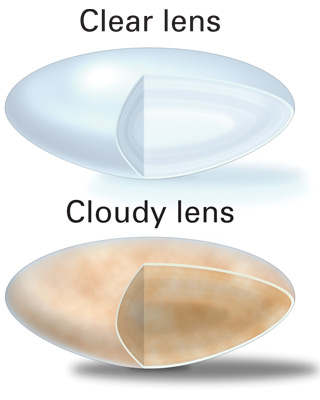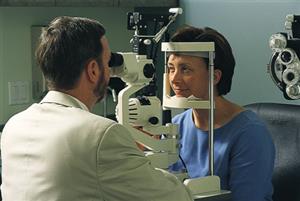Cataracts & What to Expect?

What is a Cataract?
A cataract is an eye condition that develops slowly as we age. All of us have a lens in our eye to help focus the light or an image onto our retina, so we can see. As overtime as we get older, the protein around the lens will start to clump together and cloud the lens. This protein growth and clouding on the lens is called a cataract.
At the early stages of cataracts, a new eyeglasses prescription, brighter lighting, and anti-glare sunglasses may help. However, over time the cataract will grow larger and cloud more of the lens. Then, the only effective way to remove the cataract is to remove the lens. Your cataract surgeon will remove the clouded lens and replace the old lens with a new one. At Pacific Eye Associates, we have the newest lenses available and our surgeons use the most advanced cataract techniques to help you achieve the best visual outcome.
What are the symptoms?
- Blurry, cloudy vision
- Increased sensitivity to glare, especially from the sun or oncoming car headlights
- A sudden, temporary improvement in vision of close objects called second sight
- Sudden inability to focus on far away objects, known as nearsightedness
- Changes in perception of color, particularly yellow tones
- Double vision

What to expect during a cataract consultation?
First, the technicians will review your medical history and symptoms, and perform a routine eye examination. The eye exam will measure how well you can read the series of letters and if your eyes show signs of impairment. The technician may ask whether or not if you’ve had any difficulties with your eyesight. After the routine eye exam has been completed, your doctor’s technician will dilate your pupils. It’s not uncommon for the technician to guide you back to the waiting room as you dilate.
Next, you’ll meet with your doctor. Your cataract doctor will check the health of your eyes using different instruments. With these different instruments and devices, your eye doctor will examine the front structures, as well as, the back interior of your eye, to detect any abnormalities.
If your vision can be corrected with glasses or contacts, then your doctor will provide prescription glasses to clear your vision. If your vision can’t be corrected with glasses or contacts, then cataract surgery will most likely be the solution.
Are there any ways to prevent cataracts?
Unfortunately there is no way to prevent cataracts from developing. However, a proper diet and sun protection you may slow the progression of cataracts. Some research shows that eating foods high in antioxidants like vitamins C and E may help prevent or slow their growth. As always, if you smoke, quit smoking! Smoking created more free radicals in your eyes. Radicals are toxic chemicals that harm the cells in your eyes.
Is there a cure for cataracts?
Surgery is the only way to cure cataracts. The doctor will remove your cloudy lens and replace the old clouded lens with a new one.
What are the different lens options?
There are 3 different types of lenses to choose from, monofocal, multifocal lens, multifocal toric lens.
What is a monofocal lens?
A monofocal lens offers a fixed focus for one distance. A multifocal lens has more than one point of focus. Cataract surgery may the opportunity to be less dependent on eye glasses. A multifocal lens can dramatically improve your vision. If you have trouble seeing things up close and far, then multifocal lens may be a good option.
What are the different multifocal lenses now available?
There are two different types of multifocal lenses currently available, bifocal diffractive IOLs, refractive IOLs, and extended depth of focus lens. Each of these lenses provides both distance and near vision, but each has its own set of advantages and disadvantages. Our technicians will administer a couple of different test to measure your eyes. Depending on the measurements and your lifestyle, you and your doctor will discuss and determine together which IOLs are best for you.
Will I see 20/20 after cataract surgery?
We hope so, but we can’t guarantee it. You are paying for the service and the implant, not a guaranteed result. If the eye is otherwise healthy, the vast majority of patients can achieve 20/20 vision with glasses or contact lenses.
Does the surgery take place in the office?
No, our doctors operate at the Eye Surgery Center of San Francisco and at California Pacific Medical Center. At Pacific Eye Associates, the doctors operate at the brand new surgery center and have access to state of the art machines.
How long is the surgery? Do I have to stay overnight?
No, cataract surgery is an outpatient procedure. This means that you do not have to stay overnight at the hospital. The surgery is about 30 minutes in length and then you’ll rest for about an hour at the facility. The nurses monitor your recovery and provide eyes drops upon discharge.
What happens during the procedure?
During the operation, your doctor will numb your eye area, and may give you a sedative to help you relax. Although you will be awake during the procedure, it most likely that you will not remember much of your surgery. Once you’re comfortable and the your doctor will break up the cataract into pieces using a tool that produces sound waves. The breaking up of the cataract is called phacoemulsification. The cataract pieces are then suctioned out and the new lens is placed in your eye.
Depending on how the cataract forms, an extracapsular extraction may be used. Extracapsular extraction technique is used when the cataract is best removed in one piece. This option requires a larger incision.
There’s also a refractive laser-assisted cataract surgery. Using the laser machine, the doctor will guide the laser machine to make the incisions and soften the cataract. The laser assisted option allows the surgery to make very precise incision in less time. However, it is important to note that studies have not shown that laser-assisted cataract surgery results in better visual outcomes than the traditional cataract surgery. However, using a laser instead of a scalpel may speed recovery time.
Will I need glasses after cataract surgery?
If you choose to receive a monofocal lens implanted in both eyes for distance vision, you will definitely need reading glasses after surgery. If you receive a multifocal lens there is a good chance you won’t need glasses. 80% of patients implanted with the diffractive and refractive lenses in their respective FDA clinical trials did not need glasses after surgery for distance or near vision. Of course, not every patient in the trial was spectacle independent. The odds of becoming free of spectacles are better if your corneal astigmatism is low and your eyes are healthy.
Can I be implanted with a multifocal lens in one eye only?
Yes, you can, as long as your other eye has a clear natural lens or an early cataract. If your other eye already has a monofocal implant, you may not realize the full benefit of the multifocal lens implant.
Will I need multifocal lenses in both eyes?
It is our current feeling that a multifocal lens should be implanted in both eyes ultimately to realize the full benefit of the technology. There are currently no studies demonstrating the advantages or disadvantages of combining accommodative, multifocal or monofocal lenses when surgery is performed in both eyes.
Will it take longer for my eye to recover from cataract surgery if I choose the monofocal lens?
Recovery from cataract surgery is the same whether you receive a monofocal lens or a multifocal lens. The number of appointments before and after surgery is also the same. The brain must adjust, however, to the new optical system created with the multifocal lens. This neural adaptation takes from weeks to months to occur. Patients typically notice that they become less aware of their vision as this neural adaptation takes place.
How long is the recovery time?
The recovery time varies from person to person, your eye will regain its sensation after a few hours post-surgery and recovery time may be anywhere between a few days to a few weeks. You’ll have a post-operative visit with your doctor the next day and continue to follow up with him or her until your eye has completely healed.
If you would like to learn more about Cataracts or would like to make an appointment with one of our cataract doctors, contact us today by requesting an appointment or call us: 415-923-3007.
Cataract Surgery at Pacific Eye Associates
Dr. Danny Lin, Scott So, and Karen Oxford are experienced and precise surgeons who all have 15+ years of experience. Currently, there are two ways to approach cataract surgery, laser or traditional. Laser and traditional options both have their benefits and our doctors will guide you through both methods and determine which option will work best for your eyes.
Cataract surgery is a simple and safe procedure that is quick and relatively pain-free. The doctor will make a small incision to break up and remove the cataract. Remember, in order to treat your cataract, that your old lens will be removed. This step may sound intimidating, but there are different ways to move the cataract / your old lens depending on your cataract, eyesight, and lens chosen.
Lens Removal
Depending on the type of your cataract, the lens removal may be in one of the following ways:
- Phacoemulsification (Phaco): A very small incision is made in your eye and your doctor uses an ultrasonic hand-piece to break up the cataract into small pieces. Then, the small pieces are suctioned out.
- Extracapsular Extraction (ECCE): Depending on the cataract and the circumstances, your doctor may need to remove your cataract in one piece. This option uses a larger incision.
- Refractive Laser-Assisted Cataract Surgery (ReLACS): This is the most advanced type of cataract removal. Instead of incisions, your doctor will use a femtosecond laser to make the incisions. The laser, called LenSx, will also soften and break up your cataract. Then your doctor will use an ultrasonic hand-piece to any remove the cataract.
Most patients are back to their normal activities and lifestyle the very next day. The surgery does not require an overnight stay, the procedure itself takes around 30 minutes, and the whole process takes only one to two hours. Usually, just one eye is done. If you have cataracts in both eyes, your doctors may suggest waiting at least 1 to 2 weeks between each surgery.
Custom Cataract Surgery – ORA
You can customize your cataract surgery with the ORA system. The custom cataract surgery approach will provide a better quality of vision than your standard cataract surgery. If you have some degree of astigmatism, then you may be a candidate for the ORA system. Please click on the button below to read more about the benefits of the ORA system.
The ORA system
Replacement Lens Options
Once your doctor removes your old lens, a new lens is gently placed into your eye. With technology and advances in medicine, there are now many different types of lenses to choose from. With the right lens, you may greatly improve your vision and reduce your dependency on glasses. In fact, many of our patients are able to see as well as they did during their youth. At your cataract consultation, you and your doctor will discuss your lens option in detail so you can choose the right one for your lifestyle and vision goals.
Please click on the button below to learn more about the different options available.


